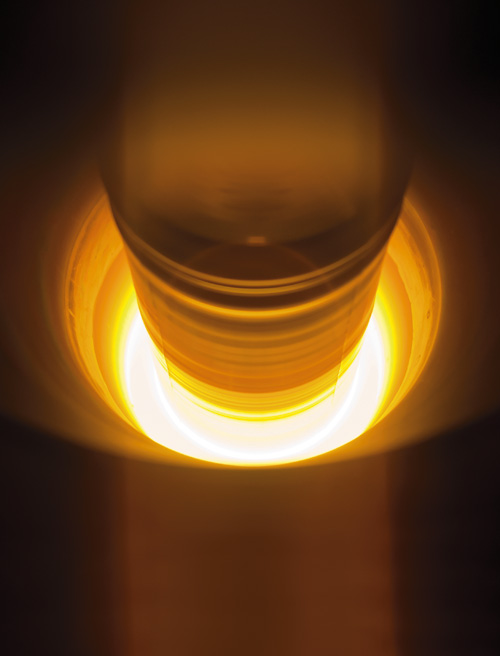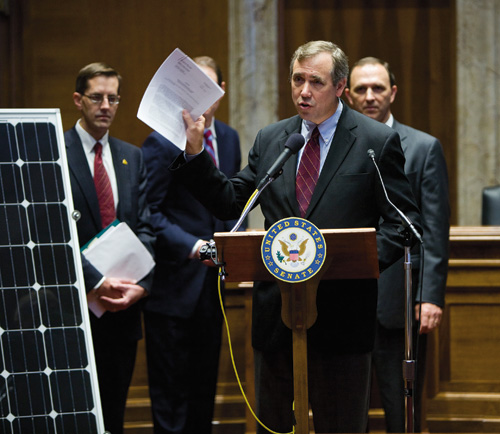 On the other side of the debate about China’s aggressive push into the U.S. solar market is this: exports.
On the other side of the debate about China’s aggressive push into the U.S. solar market is this: exports.
By Lee van der Voo
 |
U.S. Sen. Jeff Merkley speaking last fall in Washington, D.C., in support of SolarWorld at a press conference declaring unfair practices by China. Gordon Brinser, president of SolarWorld Industries America, is at right. |
On the other side of the debate about China’s aggressive push into the U.S. solar market is this: exports.
They were a bright spot on the Oregon economy in 2010, with international trade growing by 19% on nearly $18 billion in foreign sales. Nearly 5,000 Oregon companies export goods and services internationally. In September, Gov. John Kitzhaber touted many on a trade mission to Asia, stumping for Nike, Intel, wheat growers, motorcycle makers, even boat-paddle craftsmen.
China is the state’s largest trading partner, gobbling a whopping $4 billion, or 22%, of Oregon exports last year, up from $807 million in 2005. But with allegations of product dumping by China made by SolarWorld, the German company with U.S. operations and 1,000 employees in Hillsboro, and other companies in October, some trade experts say they’re worried.
Backlash is already playing out in the renewable energy world, with China making similar accusations about polysilicon dumping by U.S. companies and investigating U.S. subsidies to renewable energy. As it does, concerns about future trade tariffs are reaching beyond the solar industry to other exports.
“At the end of the day, it’s not only about SolarWorld. There are implications downstream and I always worry about the law of unintended consequences,” says Barry Horowitz, a trade expert at Portland-based CMS Consulting Services who accompanied both crab and potato reps to Asia on behalf of the Port of Portland.
As the details of U.S. solar industry’s joust with China evolve, they’re a departure from the sunny stories of four years ago, when Oregon’s budding solar industry was called “a locomotive that has already left the station, and it is accelerating” by former Solaicx CEO Bob Ford. While the industry has grown since, it hasn’t grown as expected.
An October report from the Solar Foundation estimates the industry is tied, in some way, to some 545 companies in Oregon, and supports 3,346 jobs. Business Oregon, the state’s economic development agency, estimates as many as 8,000 Oregonians are economically dependent on solar manufacturing. The sector includes manufacturers of top brands such as SolarWorld, MEMC (Solaicx) and Sanyo, as well as manufacturers of wafers and inverters, wafer cleaning companies, silicon recyclers and research facilities, and designers of PV tracking systems and test equipment.
Oregon’s semiconductor industry made it easy for solar companies to land here, tapping a workforce with similar talents, along with cheap power, an established supplier network, state incentives and a favorable tax structure. Many of these companies export products, helping bolster Oregon’s standing as eighth in the nation for exported goods.
But Oregon’s solar industry has fallen short of expectations. Some things were achieved: SolarWorld planned to create 1,000 jobs in Oregon by 2010, and did. Oregon also developed a solar feed-in-tariff pilot that, along with incentives and creative financing packages, began vigorously installing rooftop panels. The number of solar manufacturers also grew from three in 2007 to six in 2011. But that’s about half the 11 manufacturers the Oregon Economic and Community Development Department was recruiting in 2008. Solaicx sold to MEMC in 2010, which laid off 100 of its 140 Portland workers in December. There is no more state Business Energy Tax Credit, which once helped lure solar companies here.
While some predicted it would be Oregon’s low hydropower rates that would hamper solar power’s growth in Oregon, few bet that China could upend the sector.
Yet between 2008 and 2010, Chinese exports of solar cells and solar panels to the United States jumped 350%. By July 2011, the country’s exports to the U.S. exceeded the volume of all of solar exports in 2010.
SolarWorld was the first to formally cry foul. SolarWorld is the only company named in a coalition of seven filing antidumping petitions Oct. 19 with the U.S. Department of Commerce and the U.S. International Trade Commission, asking for tariffs on Chinese imports, a request that has since provoked an investigation. They charge China’s subsidies to its solar manufacturers are illegal, allowing them to dump solar cells on the U.S. market for less than the cost of making them, driving prices to artificial lows to put competitors out of business.
 |
Making a solar panel at the manufacturing facility in Hillsboro. |
Indeed, China’s push for a place in the U.S. solar market has been aggressive. And during its ramp-up, seven U.S.-based solar companies have closed or downsized over the 18 months that prices fell, with layoffs at five others. Those include some of the nation’s biggest players. BP Solar cited the global market when laying off 320 in Frederick, Md., in March 2010 and moving manufacturing to China and India. Evergreen Solar blamed China for its plant shutdown and layoff of 800 in Devens, Mass., before also sending manufacturing overseas. SolarWorld’s Ben Santarris, who is coordinating the company’s trade case, says SolarWorld closed its commercial hub in Camarillo, Calif., in September, laying off 186 workers. Santarris says American-based solar manufacturers can compete with Chinese companies on price, and possibly have an advantage: China’s low-wage workforce doesn’t compensate for the cost of importing raw materials and shipping products back to the U.S.
The coalition’s push for government intervention, called the Coalition for American Solar Manufacturing or CASM, is an attempt to save the solar industry in the United States, Santarris says, with benefits for Oregon and beyond.
“If we don’t prevail in the filing, then much, if not all, of the Western operators will go out of business,” says Santarris. “I don’t see how anybody could make a case that this is good for the marketplace, energy security, for the environment, or the economy long term.”
Oregon Sens. Jeff Merkley and Ron Wyden supported the coalition’s petitions, and the Department of Commerce could place tariffs on Chinese solar imports as early as March. The senators say the move is in part an attempt to bolster a renewable energy future for the United States. They also say maintaining solar is critical to the Oregon economy.
Merkley, who pressed the World Trade Organization for more oversight of China’s trade practices last fall, doesn’t want the Oregon solar industry to become another casualty of unfair trade, like Oregon’s paper mills, driven out of business in part by Chinese demand for recycled paper. In the steel industry, American manufacturers have made claims that echo those in solar: The Chinese government subsidizes its now massive steel industry and makes it difficult to compete.
But the irony of a German company fighting for free trade in the United States isn’t lost on some, who fear potential for fallout in the form of rising prices or increased tariffs in the trade world.
That criticism is voiced even within the solar industry, where U.S.-based manufacturers reliant on Chinese components have formed their own coalition to push back against CASM, called the Coalition for Affordable Solar Energy (CASE). They argue cheaper products make for faster solar adaptation by consumers and a more robust market. On Dec. 20, the coalition sent a letter formally asking CASM to stand down. Players in Oregon’s solar industry are also divided.
For companies selling into the Chinese market, the mantra is: “A trade war that starts setting up tariffs and all the rest of it will cut into our sales and our opportunities in China,” says Norm Eder, executive director of Oregon’s Manufacturing 21 Coalition, which advocates for industry. From their perspective, “they sure as heck don’t want to have a trade war,” says Eder, even as companies who compete directly with China cheer CASM’s efforts and scrutiny into Chinese subsidies.
While some of Oregon’s larger export industries look on, those in lumber and logs, forest products, wheat and potatoes say they aren’t worried yet, and aren’t sure they should be.
The potential for backlash, however, is not a small concern for the likes of Horowitz, who notes that while much of Oregon’s GDP comes from exports — the vast majority from computer, electronic and agricultural products — unintended consequences lurk.
“Nobody knows what the other side might do in retaliation,” he says.

